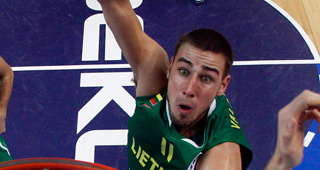Neither Anthony Davis nor Jonas Valanciunas, the two youngest basketball players in the Olympics, were much of a factor in Team USA’s narrow 99-95 victory over Lithuania. Valanciunas, despite starting for Lithuania, played nine minutes while Davis stayed on the bench in the Americans' first tight game in London.
If David Stern and Mark Cuban don’t get their way, that could be a very different story in 2016 (when Valanciunas would be 24 and Davis would be 23), 2020 and maybe even 2024, where they would both be younger than Kobe Bryant is now. Teenagers don’t aren’t generally involved in high-level international competitions, an indication of what Hubie Brown would call their “tremendous upside potential”.
But while they both wound up as top NBA lottery picks, they took radically different paths to get there. It’s very Rocky IV: Valanciunas is the Ivan Drago character, signed to a professional contract in his adolescence. Davis is the raw American, emerging essentially from nowhere as a high school junior to become the best player in the country.
Before his late growth spurt, Davis was an unheralded 6’4 perimeter player being recruited by mid-major colleges. Then he suddenly grew to 6’10 without losing any of his foot-speed. The result was the ideal combination of a center’s size and a guard’s quickness.
Valanciunas is a more conventional big man, with excellent athleticism for a 6’11, 240 center. He was identified at an extremely young age as a promising prospect, a pro by the age of 16. Two years later, he was playing for Lietuvos Rytas in the Euroleague, the second best pro league in the world.
At Kentucky, Davis was the defensive lynchpin of one of the most talented collegiate teams in a long time. The Wildcats had the No. 1, 2, 18, 29, 42 and 46 selections in the 2012 NBA Draft, and they were far too talented for most of their opponents. Their final record speaks for itself: 38-2, with only three of those wins (and none in the NCAA Tournament) coming by fewer than five points.
Valanciunas, meanwhile, was playing with players twice his age. As a result, he was a role player, rarely creating his own shot. In that context, his 2012 Eurocup stats are fairly impressive: 10.8 points, 7.6 rebounds and 1.6 blocks on 63% shooting in 23 minutes a night.
Davis was dominant at Kentucky -- 14.2 points, 10.4 rebounds and 4.7 (!) blocks on 65% shooting -- but it’s hard to imagine him having more success than Valanciunas if their roles had been reversed. When adjusted for pace and per-40 minutes, Valanciunas averaged 18.9 points, 13.4 rebounds and 2.7 blocks a game in 2012.
He would have adapted easily to the role Davis had for Kentucky - running the floor, moving the ball and catching lobs at the rim. The talent gap between the Wildcats and the other 11 teams in the SEC was about as wide as the one between Team USA and the other 11 teams in London. Valanciunas, Terrence Jones, Michael Kidd-Gilchrist, Darius Miller, Doron Lamb and Marquis Teague would still have been a huge favorite to win the Final Four.
Davis, a more fluid athlete, is the better defensive prospect. At 6’11, 220 with a 7’6 wingspan, his quickness, length and defensive timing allow him to be a dominant shot-blocker without getting in foul trouble (only 2.4 a game at Kentucky). In contrast, Valanciunas’ biggest problem next year will be his rate of 5.6 fouls per 40 minutes, an improvement from 8.2 per 40 in 2011.
On the other side of the floor, Valanciunas has developed some basic post moves, which is all a player with his size and length (7’4 wingspan) needs to score. He used a jump hook to shoot over the top of Tyson Chandler and Ronny Turiaf in London, and while it didn’t always go in, all they could do was wave at the ball and hope he missed. Davis, meanwhile, will struggle establishing deep post position next year, so he’ll have to either get stronger or refine his perimeter jumper.
Both are part of a new wave of big men of small-ball centers, making up for what they lack in pure strength with great length and lateral quickness. Neither has the bulk to bang with mammoth centers like Dwight Howard and Andrew Bynum, but they’re well suited to the more perimeter-oriented game the NBA is moving towards.
Where they go from here is unclear: just because a 20-year old could grow into something doesn’t necessarily mean they will. Maybe Davis never adds any weight and drifts out on the perimeter, where his skill-set is less valuable. Maybe Valanciunas maxes out as a more skilled version of Andris Biedrins, a big man not good enough to dominate offensively or athletic enough to dominate defensively.
Like almost all young centers, their development will depend heavily on the environment their team puts them in. Davis has a higher ceiling than Valanciunas, but the difference between the two isn’t nearly as high as their pre-draft publicity would suggest.

Jonathan Tjarks wrote on the NBA for RealGM from 2011-2016 before joining The Ringer.
Follow @JonathanTjarks on Twitter.


